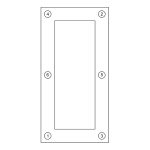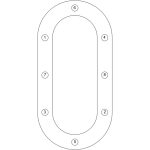During the course of our 50 years in business, Associated Gaskets has seen many different types of gasket failures. Sometimes these were seen late at night when we were called out to help with an emergency, other times it was when one of our own gaskets was returned after failing to seal. This experience has led us to develop an acute understanding of some of the common causes of gasket failure which we are sharing with you in the hope of helping limit future problems.
Though gaskets are typically one of the cheaper items in an industrial assembly, please don’t make the mistake of linking their importance with their price. One failure can lead to enormous amounts of system downtime, plant inoperability and worse; compromise worker safety. Of course, the fact that you’re reading this article suggests you do understand the important role that gaskets play in keeping systems running and plants operating safely.
Unfortunately, no matter how aware we are of their importance, sometimes gaskets do fail. Below, we detail a few of our observations by exploring the most common causes we see for gasket failure while also detailing some of the things you can do to protect against them.
Problems with Installation
In our experience, the majority of gasket failure incidents can be traced back to issues with installation. One study we saw found that of a randomly selected sample batch of failed gaskets over 70 per cent failed due to issues with the installation process with the vast majority being due to insufficient sealing load being applied. This lines up roughly with our own observations.
Correct installation of a gasket varies according to the gasket type, flange type and various other factors. That said, there are some best practices that can be adopted.
The first of these is ensuring that bolts are tightened as per specifications (the use of torque wrenches or other controlled tightening equipment is suggested whenever practicable) and tightened in the correct order. You’d be shocked to hear how many gasket failures we’ve seen over the years that had their origins in bolts being tightened sequentially around a flange rather than in the advised alternating pattern. The diagrams below show the suggested tightening sequence for a few common styles of gasket.
It is should also be noted that, in recent years, we’ve seen a significant increase in the amount of low quality bolts available on the market. Many of these can be prone to over-stretching instead of clamping as they are being tightened which will, of course, lead to issues with creating a good seal.
Another factor that, in our experience, can often lead to issues is the use of sealing aids. From time to time, installers may use different types of caulks or adhesives to assist with assembly or to help compensate for imperfect, damaged or misaligned flanges. Great care should be taken when selecting these sealing aids as some are acetic cure or contain other ingredients that can damage certain types of gasket materials (such as elastomers or rubber bonded corks). Sealing aids can also cause issues if they allow the gasket to shift on the flange face, prevent proper seating or creep into flange perfections thereby preventing the gasket from doing so.
If you are going to use a sealing aid (be it gasket goo, silicone, adhesive spray or any other product) to assist with your gaskets installation, it is highly recommended that you closely observe the instructions provided with the sealing aid, ensure that you apply it around the flange (do not brush across as this can create potential leak pathways) and make sure that the product being used is compatible with the material your gasket is made from.
Incorrect Material / Style of Gasket
Anyone who’s spoken with us here at Associated Gaskets is probably used to being asked a few questions when you enquire about the supply of a particular gasket. We’ll usually ask you about the temperature, pressure and media variables of the sealing application (in addition to enquiring about sizing and general info on the applications environment). We do this because we have found that these variables are critical in ensuring that the correct gasket material can be provided.
Thickness is another important factor in gasket design and one that is sometimes misunderstood. For gaskets, thinner is always better. It’s definitely not in our interests to say this (thinner is also cheaper) but it’s true. Far too often we have seen gaskets fail because it was mistakenly assumed that more gasket will be better. You definitely need enough thickness to allow for compression, filling of imperfections in flange faces and the creation of a good seal but you shouldn’t overdo it. Extra material will require additional loading for compression leading to undue stress on fasteners, flanges and increased chance of failure.
There’s more types, styles, brands and constructions of gasket material out there than we can count and each one has its own characteristics. Choosing the correct one for your application is absolutely critical in ensuring a good seal and long lasting performance. In this task, we’re here to help. Our 50+ years of experience means that we have seen all kinds of sealing requirements and are well versed in matching solutions to problems.
Whether you’re working from a drawing, old sample, parts list or are simply trying to work out why a flange keeps leaking, don’t hesitate to contact us as we’ll help in any way we can. In addition, for those of you who would rather get the information yourself in your own time, this website contains all kinds of information on many of our gasket materials with more being added regularly.
A useful acronym to keep in mind is S.T.A.M.P. which stands for Size, Temperature, Application, Media and Pressure. All of these factors need to be accounted for when selecting a gasket to ensure good sealing performance.
Environmental Factors
Even when a gasket’s material and style have been selected and installed perfectly, sometimes leaks can develop over time. These can be caused by a wide variety of environmental factors including, but not limited to, corrosion, vibration, reuse, thermal cycling and flange damage.
Depending on the application area, the development of corrosion can cause serious problems for an effective seal. Of course, the gasket itself becoming corroded (either by the media or surrounding environment) is the most obvious candidate for seal compromising but damage to the flanges or fasteners are also real concerns. Should either occur issues such as flange misalignment and relaxing of bolt torque can eventuate.
Another issue whose effects are apparent only over time is vibration A common consequence of most machineries operation, vibration can cause the fasteners to lose their original torque which, should it go unnoticed, may lead to an effective seal being lost. Should it be noticed and retightened, this can also cause issues as many gasket materials have a memory and are not designed to cope with repeated compression.
This point is linked to the next; that of gasket reuse. Given the short lead times associated with plant or equipment shut-downs, it is understandable that sometimes gaskets are reused. We never suggest this as performance will become compromised with each loosening and tightening cycle or a track can be formed that, under pipeline pressure, will allow a leak to persist no matter how much further tightening is done. In our experience, the best performing gasket is a new gasket.
Finally, flange damage or design problems are a recurring issue and should be mentioned. Whether it be due to problems with design (such as inadequate bolt holes/sizing for a large gasket) or damage incurred during transport or installation, problems with a flange will always lead to problems with a seal. Our experience with these issues often allows us to pick up on potential issues with a seal assemblies design when manufacturing the gasket but we can’t stress enough how important it is to properly inspect flanges for defects prior to final assembly. A hydro test (or similar, coupled with a sensitive leak detection agent) can also be useful before final commissioning.
Associated Gaskets is pleased to be able to offer a number of solutions to help mitigate the issues that environmental factors present for proper sealing. These include a full range of corrosion protection products, threadlocking compounds to prevent unwanted fastener relaxation and flange spray shields which can assist with early identification of leaks while simultaneously protecting plant and equipment from their dangers. Of course, we’re also here to help in any other we can and stand ready to use our experience, knowledge, large stock holdings and fabrication facilities to help with your sealing needs.




